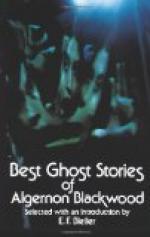To see Pan meant death. Hence in this story there is a philosophy of Pan-theism—no “me,” no “you,” no “it.” It is a mystical story, with a storm scene in which is painted a picture that reminds one strongly of “The Fall of the House of Ushur,”—with the frankly added words, “On him were marks of hoofs of a monstrous goat that had leaped on him,”—uncompromising mysticism.
Happy is the Kipling selection, “The Phantom ’Rickshaw,” if only for that obiter dictum of ghost-presence as Kipling explains about the rift in the brain: “—and a little bit of the Dark World came through and pressed him to death!”
Then there are the racial styles in ghost stories. The volume takes us from the “Banshees and Other Death Warnings” of Ireland to a strange example of Jewish mysticism in “The Silent Woman.” Mr. French has been very wide in his choice, giving us these as well as many examples from the literature of England and France. Finally, he has compiled from the newspapers, as typically American, many ghost stories of New York and other parts of the country.
Strange that one should find humor in a subject so weird. Yet we find it. Take, for instance, De Foe’s old narrative, “The Apparition of Mrs. Veal.” It is a hoax, nothing more. Of our own times is Ellis Parker Butler’s “Dey Ain’t No Ghosts,” showing an example of the modern Negro’s racial heritage.
In our literature and on the stage, the very idea of a Darky and a graveyard is mirth-provoking. Mr. Butler extracts some pithy philosophy from his Darky boy: “I ain’t skeered ob ghosts whut am, c’ase dey ain’t no ghosts, but I jes’ feel kinder oneasy ’bout de ghosts whut ain’t!”
Humor is succeeded by pathos. In “The Interval” we find a sympathetic twist to the ghost story—an actual desire to meet the dead.
It is not, however, to be compared for interest to the story of sheer terror, as in Bulwer-Lytton’s “The Haunted and the Haunters,” with the flight of the servant in terror, the cowering of the dog against the wall, the death of the dog, its neck actually broken by the terror, and all that go to make an experience in a haunted house what it should be.
Thus, at last, we come to two of the stories that attempt to give a scientific explanation, another phase of the modern style of ghost story.
One of these, perhaps hardly modern as far as mere years are concerned, is this same story of Bulwer, “The Haunted and the Haunters.” Besides being a rattling good old-fashioned tale of horror, it attempts a new-fashioned scientific explanation. It is enough to read and re-read it.
It is, however, the lamented Ambrose Bierce who has gone furthest in the science and the philosophy of the matter, and in a very short story, too, splendidly titled “The Damned Thing.”
“Incredible!” exclaims the coroner at the inquest.




